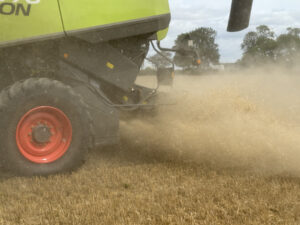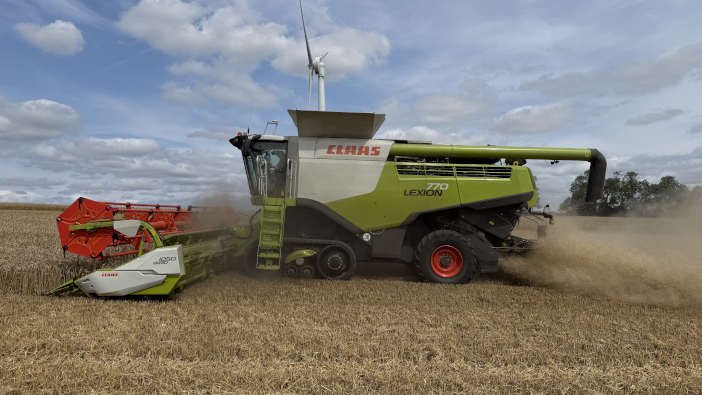Yorkshire-based farming business, Roberts Enterprises, grows around 243ha of cereals, primarily wheat and oilseed rape, previously established on a min-till basis, with rotational ploughing.
According to owner John Roberts and farm manager Daniel Scase, reducing the amount of tillage had brought several benefits to the business, but in recent years it had led to a significant increase in grassweed pressure.
“It had got to the point where we couldn’t control it with the sprayer,” John explains. “Every time we ran the combine, we were adding more seeds to the bank in the soil.”
The weed pressure had gotten to a point where, before the 2025 harvest, they sprayed off nearly 20ha of crop. “That represented a loss of £35,000,” Daniel notes. “So, it became clear that we needed to look at alternative methods of control.”
They initially saw the Seed Terminator on the Zurn stand at Cereals in 2024, and after multiple discussions on the farm and their own research, reached out to George Dance, sales manager for the UK, and Ripon Farm Services. “George looked after us from day one,” says Daniel. “We were apprehensive because it’s a significant investment, but we were able to get a grant through the Farming Equipment and Technology Fund, and to be honest, we couldn’t afford not to be more proactive with our weed control.”
Seed Terminator
The Seed Terminator is a multi-stage hammer mill that fits onto the back of the combine and processes residues from the sieves. It is belt-driven, requiring between 80-100hp from the chopper driveline, and uses hardened steel flails and a tungsten rotor, rotating at 300kph, to crush or shear seeds against the screens. Zurn states a 98% kill rate of all seeds that pass through the system.
A small display is delivered with the unit, which mounts in the cabin and alerts for vibration and oil temperature, as well as rotational speeds for the left and right mills. A warning sounds when the milling speed drops below 90%, allowing the operator to slow the combine down and avoid a blockage.
“It arrived on-farm about two weeks before we started cutting, and we saw the difference almost immediately,” says John. “Our stubble was the cleanest in the area, and it evens up the chaff across the field as well because so much is diverted through the mill.”
 It’s mounted on the back of a Claas Lexion 770. Daniel explains that while the added power requirement is noticeable, it hasn’t significantly impacted the throughput of the machine or increased the fuel consumption. Nor is it any louder in the cabin, despite sounding like a ‘jet engine’ according to John.
It’s mounted on the back of a Claas Lexion 770. Daniel explains that while the added power requirement is noticeable, it hasn’t significantly impacted the throughput of the machine or increased the fuel consumption. Nor is it any louder in the cabin, despite sounding like a ‘jet engine’ according to John.
“We were told that adding the Seed Terminator would mean we had the equivalent of a Lexion 760, and depending on conditions, we’re using about 100 litres of additional fuel per day, but that’s a small cost when you consider the losses we were seeing.”
Both are quick to highlight the service they’ve received, both at a dealer and manufacturer level; something especially important when you’re one of the first to have a machine.
Daniel notes that they had what turned out to be a rather trivial issue late on Saturday night. “I messaged George to explain the problem, and he was straight on the case. He contacted the team in Germany for answers to my problem. To be honest, I wasn’t expecting a quick response.
“When I got home around 10.30pm, George had messaged me with a solution for the problem. This was especially impressive considering they’re an hour ahead in Germany!”
Tools for a new system
While they’re impressed with the Seed Terminator, both John and Daniel recognise that it has to be part of a wider system of mechanical weed control. “We’re not going to find the answer in a bottle anymore,” says John.
One unavoidable issue is that many weeds will have gone to seed before the combine enters the field. Despite this, they believe that around 30% of seeds will be killed off with each pass of the Seed Terminator, representing a significant reduction in the seedbank each year.
“This will be ideal for the ryegrass we’re struggling with, as this is later shedding its seeds. To maintain control over the rest, we’re going back to a plough-based system to give us a clean start ahead of each crop,” Daniel notes.
And the Seed Terminator will be a key part of their future systems. John says that they will fit it to the next combine when it comes time to change. “It’s another tool that we can use to ensure our crops remain profitable. By cutting back the weed pressure at the source, we can be more confident in the other control methods.”


